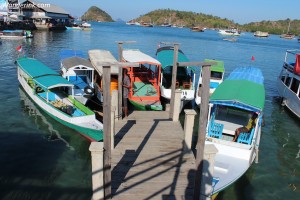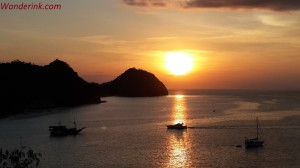It was a rare event – Wally was quiet. And Wally was never quiet, as his friends vouched, unless he was sleeping nor still if he wasn’t staring you down enquiring after the ‘angle of the dangle.’ Then at the Tree Top Bar which he runs with his son Mathews close to the Labuan Bajo harbour there is always some reason to be raucous. Like when I walked in Mathews had just announced that he had got a new dog and everyone raised a toast to Mathews’ happiness. ‘May it bring you the joy none of your bitches could,’ Wally did his fatherly bit barely lifting his own bottle of Bintang.
We were now sitting on the terrace of the bar, smoking. He reminisced his diving days, squinting at the spangled waters, how his love for the deep sea led to his collaboration for the definitive guidebook ‘Diving Bali – The Underwater Jewel of Southeast Asia.’ We – Wally, rather – were making more noise than the entire Australian family who sat next to us.
“See this?” He asked pointing to an inscription on his Zippo lighter, a gift from a former lover. DDTB, it read. I didn’t have to ask him, nobody has to ask Wally anything.
“Diving, drinking, talking bullshit, in that order.”
More raspy laughter. I saw a kid in the group put away her Kindle while another rummaged his rucksack for headphone.
Wally had moved here in the 80s when Bajo, as locals call it, was not even a blip on the tourism map. He had begun his career as a diving instructor in 1976 and came here when his clients began to demand a change of scene from ever-bustling Bali.
“You know the harbour then was a small, quaint one with some trees, beneath which were a few benches for passengers and a small harbour master’s office.” He said. Difficult to believe as earlier that day I had ojek-ed my way around it and found a melee of ferries and freight carriers and fishing boats. I didn’t see a single tree either.
“The entrepreneurs pumping in the money have no respect for the environment – just filling up more and more of the sea with earth levelled out of mountains in the name of development.”
“Maybe that’s how Bajo is poised to be the next Bali?” I asked what I had seen gloated about in tourism manuals and trade journals.
Wally stared at me long and hard.
And quiet.
Bali
No camera can capture the real beauty of Balinese women, wrote travel writer SK Pottekkatt in Bali Island. The reason for the enamoured proscribing was because ‘their real beauty lay not in their bodies or countenance, but in their mellifluous movements.’ To view a woman from behind, he further lamented, would be not to know whether she was young or old – such is the grace. So moved he was, he even went on to find the makings of this stately posture: ‘From an early age, the girls are made to walk with heavy loads on their heads forcing them to walk steady and not dawdle, head held high. The total effect, he gushes literally, is like each limb playing its own little symphony – together making up the marvellous orchestra that is a Balinese woman in motion. Nearly six decades after he wrote these I can tell you nothing has changed. The women of Bali are still captivating.
Once in Ubud, upland Bali, I was waiting for a friend outside her house when I espied an old lady in the neighbourhood offering puja to a Ganesha idol. The grace with which she went about her ritual brought to mind the famed Legong dance of Ubud I caught the previous evening. She turned to me and smiled. It was then I realised that a smitten me was way inside her boundary gate. Instead of a gesture that conveyed immediate defenestration of my unsolicited presence she smiled. Even asked me whether I didn’t want pictures. One of life’s most memorable pleasures are such little, unexpected goodness of total strangers. And Bali bamboozles you with oodles of it.
“The people of Bali are good from here,” said Agung Rai, thumping his heart. Rai ran a travel business in Kuta, the famous beach area of Bali. We were on our way to the Monkey Forest and I had pointed out to the general absence of honking on the roads. Coming from India my eardrums were pining for cacophony.
“We drive with our hearts and not as per rules.” Rai said. “In fact, we do everything with our hearts,” he reiterated the charm of the island which had for centuries enchanted many of those passing by enough to settle down for good. One notable example is artist Antonio Blanco. Born to Spanish American parents in the Philippines, Blanco worked in Florida for a while before turning to the Pacific islands for inspiration. He found plenty in Bali and stayed on till his death in 1999. In the meantime, he married a famous Balinese dancer, sired several children, friended many notables including Michael Jackson, won many awards and opened a museum. The Renaissance Museum in Ubud is an abiding testimony to the charms of Bali, though most of them are portraits of nubile, young bare-breasted women, which made Blanco flower as an artist. When I visited, an elegant looking lady placed a frangipani flower behind my ear and welcomed me with a comely smile. Made me consider strongly settling in Bali.
Then, Bali will never change because it never has. It has traditionally remained rooted in and loyal to its beliefs and culture. Hinduism, which was brought in during the seventh century by scholars travelling with Indian merchants continues to thrive here. While a hop skip across the waters, over many islands in the archipelago, Islam brought in by Chinese traders a few centuries later became the dominant religion. Like the dear old lady with the Ganesha, every house in Bali has its own temple or pura. Most house constructions in Bali begin with that of the pura, usually next to the entrance gate itself, and the installation of an elaborately carved deity. Equally important as places of worship, the puras are also where ancestors are revered. These, Rai told me, was a non-negotiable regardless of economic status. I rode most the way to the Monkey Forest staring wondrously at these little shrines of private devotion abounding in variance accorded not just by social (caste system is prevalent in Bali) and financial statures but the person’s spiritual realm and geographical locations. Sheer aesthetics even. So much for Suharto’s attempts at enforcing dull uniformity across the land.
A later journey to villages beyond Ubud to see some of the locations of ‘Eat, Pray, Love’ I passed through some ‘split gates’ common in Bali. These are intricate, arch-shaped gates with a mirror symmetry and are locally known as candi bentar.
“Well, this gate is candi bentar,” she said about the one we were passing through. “Then there is the kori agung with roofed tops found within a pura complex.”
I was enthralled. I should really move here.
Bajo
Tragedies have a way of redemption through rediscoveries. Talks of an alternate to Bali began in right earnest after a suicide bomber killed over 200 in a packed nightclub in Kuta in 2002. It didn’t take long for many to make a beeline to Labuan Bajo in Flores island, a shanty beachside town slogging its way up the respectability and popularity ladder. Fish wholesale was the economy’s backbone; the local fish market is still an eye-opener to the astounding diversity and generosity of the sea. I strolled around gawping at the largest varieties of fish I had ever seen under one roof, the dried ones grinned back at me. The pace of development has picked up in the last few years with most of it restricted to the area around the promenade and the flanking street Soekarno Hatta. ‘Bajo Dive’ is one of the oldest establishments where I met Patris, a diving instructor. The rising prospects of Bajo impelled his move from Bali a few years ago.
“But, I don’t want Bajo to be the next Bali,” he said. “I moved here because Bajo was not Bali.” I wanted Patris to tell me more about the ‘not Bali’ bit of Labuan Bajo but by then the group he was taking diving to the Pink Islands arrived. Donnie Pramaffandi took me a bit forward with that. The spiffy Donnie who works with Kalstar Aviation said he hoped Bajo remained the quiet and rusty town it was always. But from the ground it was pretty clear that the chances of Labuan Bajo remaining so was thin.
“There are large investments happening here by Italians and Australians mostly fronted by locals,” revealed Kasim Mambut, proprietor of the Ayo Mandiri Foundation where the blind are trained to be masseurs. “And these investors are in a hurry to make their monies that they don’t care about the locals or the environment.” Tourist arrivals in 2013 was 54,147 – a number projected to grow ten times by 2019. Readying the necessary infrastructure will take USD 1.2 billion of which private investments are expected to form a large chunk. One fallout of this, besides the ever-expanding land fill are the haphazard constructions that are coming up around the bay area adhering to no safety and environment norms. Putting on his ‘professor’ avatar (the others are ‘popular’ or ‘profane’ depending on how you look at it) Wally warns that if it was a bomb in Bali, it will be a natural calamity in Bajo.
I had to point out that despite what his friends said he was silent for a long while.
“See, in Bali we even have the Nyepi festival where we celebrate a day of silence,” he said standing up to go downstairs. We had run out beer.
“So are you silent on Nyepi?” I asked.
“The angle of the dangle, my friend, is Bajo can never be Bali.”


















